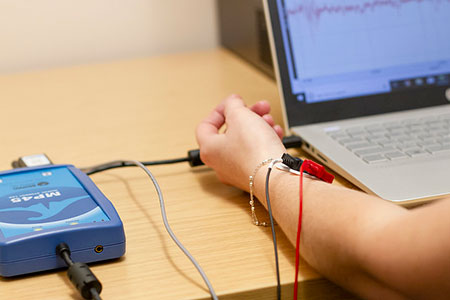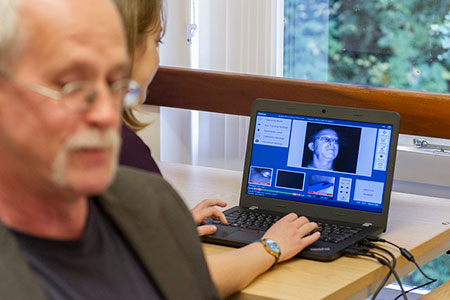The project adopted approaches and techniques from cognitive linguistics, corpus linguistics, marketing, and cognitive and social psychology. A series of experiments were conducted to determine how the metaphorical and metonymic content of multimodal advertisements is understood by potential consumers and the ways in which these appeal to consumers. These experiments included the use, among others, of the following mixed-methods approach of lab experiments, qualitative inquiry, corpus and statistical analyses:
Mental chronometry (ePrime) measures reaction times, which is the duration between viewing a stimulus and eliciting a behavioural response or completing a perceptual-motor task. It is particularly useful in experimental and cognitive psychology, while also being very insightful for marketing, that tests how viewers, or consumers, respond to stimuli, such as advertisements.
In psychometric psychology reaction times are considered to be an index of speed of processing i.e. how fast the thinker can execute the mental operations needed by the task at hand. In turn, speed of processing is considered an index of processing efficiency. The behavioural response is typically a button press but can also be eye movement, a vocal response, or another observable behaviour.
 Electrodermal activity (EDA) (Affectiva GSR Qsensor) is the property of the human body that causes continuous variation in the skin’s electrical characteristics. The traditional theory of EDA holds that skin resistance varies with the state of sweat glands in the skin. Sweating is controlled by the sympathetic nervous system, and skin conductance is an indication of psychological or physiological arousal. If the sympathetic branch of the autonomic nervous system is highly aroused, then sweat gland activity also increases, which in turn increases skin conductance. This can be a measure of emotional and sympathetic responses. More recent research and additional phenomena suggests this is not a complete answer, and research continues into the source and significance of EDA.
Electrodermal activity (EDA) (Affectiva GSR Qsensor) is the property of the human body that causes continuous variation in the skin’s electrical characteristics. The traditional theory of EDA holds that skin resistance varies with the state of sweat glands in the skin. Sweating is controlled by the sympathetic nervous system, and skin conductance is an indication of psychological or physiological arousal. If the sympathetic branch of the autonomic nervous system is highly aroused, then sweat gland activity also increases, which in turn increases skin conductance. This can be a measure of emotional and sympathetic responses. More recent research and additional phenomena suggests this is not a complete answer, and research continues into the source and significance of EDA.
 Eye tracking (EyeLink) is the process of measuring using an eye tracker device either the point of gaze (where one is looking) or the motion of an eye relative to the head. Eye trackers are used in research on the visual system, in psychology, in psycholinguistics, and marketing as an input device for human computer interaction, and in product design. There are several methods of measuring eye movement. The most popular method uses video images from which the eye position is extracted.
Eye tracking (EyeLink) is the process of measuring using an eye tracker device either the point of gaze (where one is looking) or the motion of an eye relative to the head. Eye trackers are used in research on the visual system, in psychology, in psycholinguistics, and marketing as an input device for human computer interaction, and in product design. There are several methods of measuring eye movement. The most popular method uses video images from which the eye position is extracted.
Qualitative interviews helped the project team ascertain how, when and why emotions are induced in advertisements and to determine the type, intensity and duration of experienced emotions in response to advertising and viral advertising, static and dynamic material.
Experiment design and distribution software (ePrime, Qualtrics, Prolific), were used to produce comprehensive and efficient experiments that present participants with advertisements varying in figurative messaging in order to test their effectiveness with different groups of people. Experiments testing advertising campaigns have been conducted in-house, through partner databases, and through online distribution tools (allowing distribution to an international pool of participants).
Corpus analysis tools (AntConc, SketchEngine, WMatrix) have enabled the researchers to analyse the transcribed spoken responses and written responses of participants in the experiments to stimuli being tested. These corpus analysis tools have allowed the identification of frequent words and meanings used by particular groups of participants (e.g. according to age, gender, sexuality, and ethnicity). These tools have also enabled the comparison between the control and variable groups to understand how differences in figurative messaging (i.e. the use of metaphor and/or metonymy) in advertisements have affect consumer attitudes and behaviour.
 Statistical analysis software SPSS (Statistical Package for the Social Sciences) and R (computer programming) have facilitated comprehensive statistical analyses of the data collected from the series of experiments conducted.
Statistical analysis software SPSS (Statistical Package for the Social Sciences) and R (computer programming) have facilitated comprehensive statistical analyses of the data collected from the series of experiments conducted.
